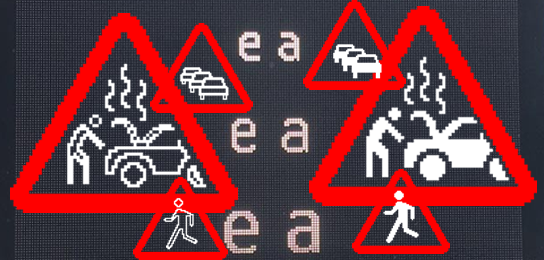
Results of comparative test on detail-discriminability of symbols and typeface characters presented on VMS, performed on 22 and 23 of January 2019.
→ Dieser Text ist auch in Deutscher Sprache abrufbar.
The framework provided by standard EN12966, relevant for Variable Message Signs (VMS), requires decisions to be made with regard to open questions concerning details (particulars) of images depicted on VMS, in order to attain optimal visual perceptibility.
For this purpose, calculation models and design principles that determine the discriminability of symbolsI and text on road signs over specific viewing distances (first established in project SOMS/In-Safety) are to be tested for their applicability for VMS by comparing images whose graphical rendering adheres to these principles with images that may be considered as current best practice.
Due to the desired harmonisation of the depiction of image content found on conventional road signs made of retro reflective materials with those shown on VMS, the experiments and results laid out in this report are geared to provide the necessary basis for decision-making.
Primary goals
a) Determination of a preferred form of graphical rendering for symbols shown on VMS:
– filled forms, as required for common road signs,
– or by a line following the contour, as propagated by industry representatives.
b) Determination of the degree of discriminability of the tested symbols.
Secondary goals
c) Identification of design criteria to further optimise discriminability of
depictions on VMS
d) Definition of the dimensions of the triangular Border of danger warning
signs to be used on VMS to allow for a display area for symbols that is as large as possible
e) Determination of the viewing distances, at which discriminability of
TernVMS typefaces manifest, and the related viewing time
f) Empirical insights concerning the setting of VMS luminance control
g) Assessment of the effects of anti-aliasing
Summary of results
Overall, evaluations confirm better discriminability as well as a general preference for the “filled- form” symbol-rendering, independent of viewing distance and light conditions (day or night). It is therefore recommended to use this form of symbol depiction for VMS, since the presentation in the form of contour lines has deficits that contradict application and limit the number of symbols due to reduced distinctness.
Measures to optimise the discriminability of symbols and text through criteria for graphical rendering, luminance adjustment and the anti-aliasing function are proposed.
Criteria for an optimal triangle-shaped Border for a depiction of danger warning signs on VMS are established.
Viewing distances for discriminability of TernVMS typeface characters and the related viewing times per driving speed and visual acuity are determined.
Please note that the Report (PDF, 2.7 MB) is written in German language. It’s results were later applied for the creation of road signs for LED-VMS in Austria, ASFiNAG project 49923 (2021).
Pingback: Road sign “Objects, obstacles or parts (fallen) on the road” – Stefan Egger, visys.pro